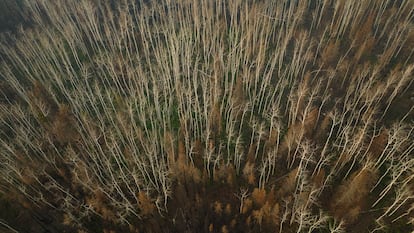Vanishing wilderness: Deforestation devastation pushes Canada’s boreal forest to the limit
A recent study highlights the severe consequences of decades of logging in old-growth woodlands


In 1999, filmmaker Robert Monderie and singer-composer Richard Desjardins (often called Quebec’s Bob Dylan), released L’Erreur boréale (The Borealis Error, in English), a documentary film aimed at exposing over-exploitation of forests in the Canada’s French-speaking province. Despite government officials and the forestry industry labeling it as “alarmist,” the documentary had a significant impact on the public. A recent study offers detailed insights into the damage to boreal (northern) forests in Quebec and Ontario, two of Canada’s major logging provinces.
According to the study by Australian and Canadian researchers, between 1976 and 2020, approximately 34.5 million acres (14 million hectares) of boreal forest were cleared in these provinces. This area is equivalent to twice the size of the Mexican state of Veracruz and larger than England. Most of the cleared area comprised forests that were over a century old. The researchers also noted that human encroachment in the remote region has led to widespread patches of cleared land in the 52 million acres (21.2 million hectares) of old-growth forests.
The researchers reviewed logging inventories created by the governments of Quebec and Ontario, and analyzed satellite images and maps. “This approach enabled us to determine when the forests were cut and their relative age, providing insights into the level of old-growth forest loss and fragmentation,” said Pierre Drapeau, a biology professor at the University of Quebec in Montreal. The study shows that Canada’s forest sustainability strategy focuses on maximizing lumber production and regenerating commercially valuable trees, which has degraded the age structure of boreal forests and negatively affected ecosystems.
One of the consequences discussed extensively in the scientific article is the plight of the caribou, also called the American reindeer. Out of the 21 caribou populations observed, 19 are deemed to be at high or very high risk. “Mature, old-growth forest is the ideal environment for caribou. When we disturb this environment, there is a greater risk of extinction,” said Drapeau, noting that flora and various species of insects and birds also suffer from habitat disturbance. “The mandate for sustainable forest management is not being met. It’s important to consider not only the quantity but also the selection of trees being cut down, all with the goal of preserving biodiversity.”
In 2023, Canada suffered its worst wildfire season ever. Flames destroyed nearly 46 million acres (18.5 million hectares), an area larger than Florida. Drapeau says their study also revealed regeneration problems in young forests compared to older ones. “Throughout millennia, various trees species have evolved to withstand fires. One way is through their seeds, which are shielded by cones and later sprout into new trees. However, this process primarily applies to mature trees. Younger forests face challenges when it comes to regenerating themselves as effectively as older ones.”
The study highlights the crucial role of Canada’s forests in combating climate change. However, the country’s forestry strategy has primarily focused on economic factors. In November 2023, over 100 scientists from various countries addressed a letter to Prime Minister Justin Trudeau calling on him “to recognize and address the significant damage that industrial logging is causing to Canadian forests.” The letter said logging in “primary and old-growth forests” erodes their value for the climate, biodiversity and water filtration.
The Trudeau administration has implemented a strategy to tackle climate change that includes a carbon pricing program, expansion of protected areas, and a plan to reduce greenhouse gas emissions. In early December, the Ministry of Environment and Climate Change unveiled a framework to limit emissions from the economically vital oil and gas industry, set to take effect in 2026. Canada’s forestry industry is also important, and Trudeau has often emphasized the need to protect the boreal forests. Changing the country’s approach to forestry exploitation would greatly contribute to achieving this objective.
Sign up for our weekly newsletter to get more English-language news coverage from EL PAÍS USA Edition
Tu suscripción se está usando en otro dispositivo
¿Quieres añadir otro usuario a tu suscripción?
Si continúas leyendo en este dispositivo, no se podrá leer en el otro.
FlechaTu suscripción se está usando en otro dispositivo y solo puedes acceder a EL PAÍS desde un dispositivo a la vez.
Si quieres compartir tu cuenta, cambia tu suscripción a la modalidad Premium, así podrás añadir otro usuario. Cada uno accederá con su propia cuenta de email, lo que os permitirá personalizar vuestra experiencia en EL PAÍS.
¿Tienes una suscripción de empresa? Accede aquí para contratar más cuentas.
En el caso de no saber quién está usando tu cuenta, te recomendamos cambiar tu contraseña aquí.
Si decides continuar compartiendo tu cuenta, este mensaje se mostrará en tu dispositivo y en el de la otra persona que está usando tu cuenta de forma indefinida, afectando a tu experiencia de lectura. Puedes consultar aquí los términos y condiciones de la suscripción digital.
More information
Archived In
Últimas noticias
Nazareth Castellanos, neuroscientist: ‘We need to teach anxiety prevention techniques from school onwards’
Oona Chaplin: ‘I told James Cameron that I was living in a treehouse and starting a permaculture project with a friend’
Madrid, the second region in Europe with the most roundabouts thanks to urban speculation: One for every 30 intersections
Amy Taylor, singer of Amyl and the Sniffers: From selling nuts to opening for AC/DC
Most viewed
- Charles Dubouloz, mountaineering star, retires at 36 with a farewell tour inspired by Walter Bonatti
- CBS in crisis after pulling a report on Trump’s deportations to El Salvador (which later leaked online)
- Venezuela faces its most tense Christmas yet
- Bukele clan fumes over investigation exposing their new wealth
- Why we lost the habit of sleeping in two segments and how that changed our sense of time










































